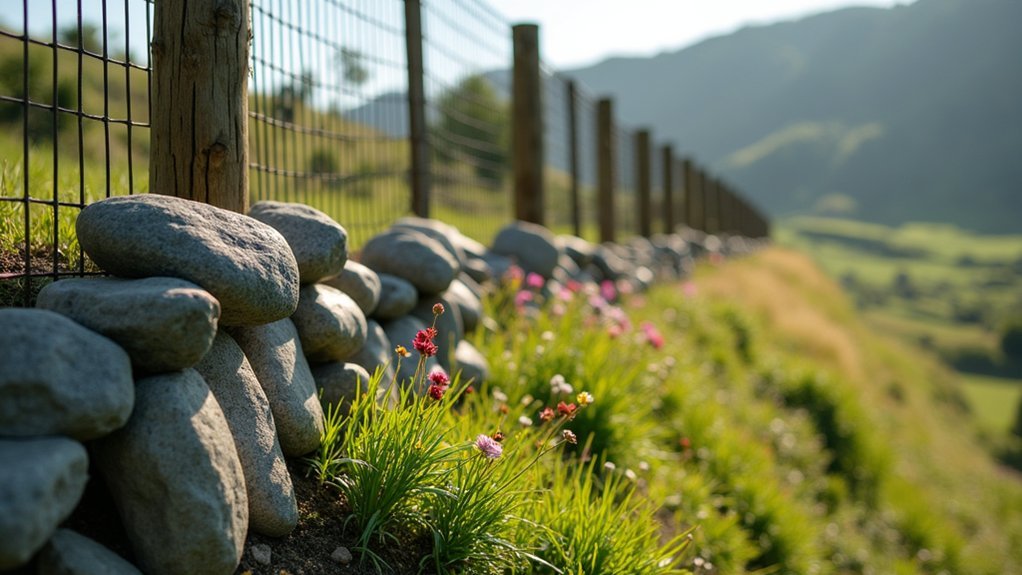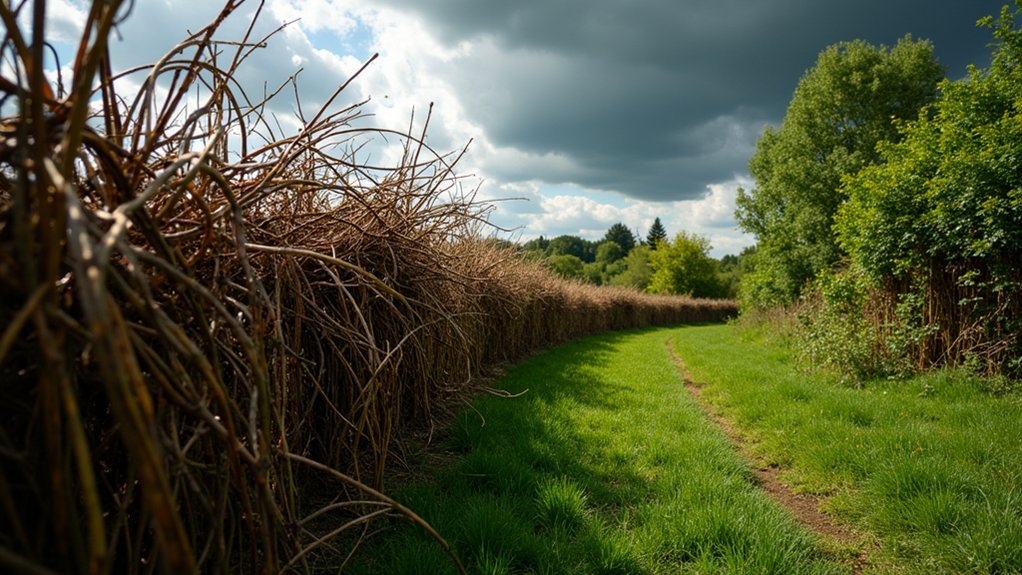The most climate-resilient permaculture fencing solutions include living hedgerows that reduce wind speeds by 50% while fixing nitrogen, hugelkultur boundaries that retain water while deterring wildlife, stone gabion structures that prevent flooding, solar-integrated electric fencing for rotational grazing, and woven willow windbreaks that bend rather than break in storms. You’ll benefit from these sustainable options that last decades longer than conventional fencing while enhancing biodiversity. The following solutions offer detailed implementation strategies for your specific site conditions.
Living Hedgerows: Biodiversity Barriers for Extreme Weather Protection

As climate change intensifies, living hedgerows offer a remarkably effective defense against extreme weather conditions while doubling as biodiversity hotspots.
You’ll find these natural barriers reduce wind speeds by up to 50%, protecting your crops and livestock during storms.
By incorporating nitrogen-fixing species into your hedgerow design, you’re enhancing soil health and creating plants better equipped to withstand drought and flooding.
The dense vegetation structure absorbs and filters rainwater, considerably reducing erosion and runoff during heavy precipitation events.
What makes living hedgerows particularly valuable for climate resilience is their longevity—surviving over a century while continuously adapting to climatic changes.
This permanent ecosystem resilience feature creates a sustainable windbreak solution that improves with age, providing long-term benefits far exceeding those of conventional fencing options.
Hugelkultur Boundary Systems: Water-Retaining Fence Alternatives
While living hedgerows work vertically to create protective barriers, Hugelkultur boundary systems leverage horizontal space to establish multifunctional fencing alternatives.
These innovative structures use decomposed wood and organic materials to form raised beds that excel at water retention, reducing your irrigation needs while enhancing soil fertility naturally.
You’ll find these natural barriers effectively deter livestock and wildlife while creating habitats for beneficial organisms, boosting biodiversity on your property.
By implementing Hugelkultur berms as sustainable fencing, you’re creating productive microclimates that optimize growing conditions on both sides of the boundary.
The layered construction prevents soil erosion while improving soil structure as materials break down.
Unlike conventional fencing, these renewable resources remain functional for decades, offering long-term ecological benefits.
Your Hugelkultur boundaries become increasingly valuable assets as they mature, continuing to enrich your permaculture landscape year after year.
Stone Gabion Structures: Flood-Resistant Perimeter Solutions

When traditional fencing fails against severe weather events, stone gabion structures emerge as superior alternatives for climate-resilient boundaries.
Stone gabion structures offer resilient, eco-friendly alternatives when conventional fencing succumbs to climate extremes.
These durable perimeter solutions utilize wire mesh containers filled with local stones, creating robust barriers that withstand erosive forces during heavy rainfall.
You’ll appreciate how these structures absorb and redirect water flow while enhancing soil stability around your property. Their natural drainage properties prevent waterlogging, effectively mitigating flood risks.
What makes stone gabions particularly valuable for permaculture designs is their environmentally friendly nature. By using local materials, you’re reducing transportation emissions and embracing sustainable building practices.
Additionally, these porous walls serve as wildlife habitats, enhancing biodiversity while functioning as effective boundaries. The multi-purpose nature of gabions makes them an excellent investment for climate-conscious permaculturists seeking long-term protection.
Adaptive Electric Fencing With Solar Integration
Beyond physical stone barriers, modern permaculture demands flexible boundary solutions that adapt to changing conditions.
You’ll find adaptive electric fencing with solar integration perfectly aligns with permaculture principles while maintaining essential ecosystem connectivity.
By installing solar-powered electric fences, you’re creating energy-independent security that works brilliantly in remote locations.
Set up custom grazing cells to implement rotational grazing techniques that enhance pasture health and boost soil fertility through natural manure distribution.
For maximum effectiveness, position multiple wire strands at different heights to deter predators while still accommodating wildlife corridors.
This approach requires minimal materials compared to conventional fencing, making it a cost-effective solution for sustainable land management.
The versatility of electric fencing allows you to reconfigure boundaries seasonally, adapting to your permaculture system’s evolving needs without permanent landscape alteration.
Woven Willow Windbreaks: Flexible Barriers for Storm Resilience

Unlike rigid fencing alternatives, woven willow windbreaks offer remarkable resilience in the face of increasingly unpredictable weather patterns. You’ll appreciate how these flexible barriers bend rather than break during strong winds, creating durable protection for your permaculture system.
| Benefit | Impact | Outcome |
|---|---|---|
| Storm Resilience | Withstands harsh weather | Protects your investment |
| Wildlife Habitat | Attracts beneficial insects | Enhances biodiversity |
| Microclimate Creation | Reduces wind speed | Nurtures sensitive crops |
The rapid growth of willow species means you’ll establish effective windbreaks quickly. As living structures, these climate-resilient barriers continuously regenerate through proper pruning. Beyond protection, they create valuable ecological niches, transforming a simple boundary into a multifunctional permaculture element that strengthens your garden’s resilience against climate extremes.
Frequently Asked Questions
How Do Maintenance Requirements Change With Seasonal Climate Variations?
Maintenance requirements change considerably as seasons shift. You’ll need more frequent checks during wet seasons for rot, reinforce fencing before winter storms, and monitor for expanding wood in summer heat. Regular seasonal inspections are essential.
What Are Typical Installation Costs Compared to Conventional Fencing?
You’ll spend 20-100% more upfront for permaculture fencing than conventional options. Living fences cost $3-8 per foot, while traditional fencing runs $2-15 per foot. You’re investing in long-term sustainability and reduced maintenance.
Can These Solutions Be Retrofitted to Existing Fence Structures?
Yes, you can retrofit most permaculture fencing solutions to existing structures. Simply add living components like vines to chain link, attach wattle panels to posts, or plant hedgerows alongside conventional fences for enhanced resilience.
How Long Until Living Fence Systems Provide Effective Protection?
Living fence systems take 2-5 years to provide effective protection, depending on your climate, species chosen, and maintenance. You’ll need temporary fencing until they’re established. They’ll last decades once mature.
What Permitting Challenges Exist for Alternative Fencing in Various Jurisdictions?
You’ll face height restrictions, setback requirements, and aesthetic regulations when installing alternative fencing. HOAs often impose strict guidelines, while some municipalities require permits for living fences or have native species restrictions you must navigate.
In Summary
You’ve discovered how permaculture principles can transform your property boundaries into climate-adaptive assets. Whether you’re implementing living hedgerows that support wildlife or building hugelkultur systems that conserve water, these solutions offer more than protection—they’re regenerative systems working with nature, not against it. As weather extremes intensify, your fencing choices aren’t just practical decisions but meaningful contributions to a more resilient landscape.





Leave a Reply